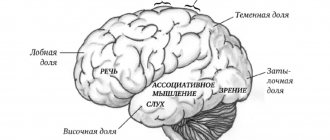A little theory
Before exploring the issue of interpersonal perception errors, it is worth examining the theoretical foundations of this category. Perception is the sensory knowledge of objects and phenomena in the environment. Perception is believed to be the basis of cognition. Perception occurs at the following levels:
- Detection is the initial phase of perceptual development.
- Discrimination is the process of forming a reference image of a situation.
- Identification is the identification of the received image with those stored in consciousness.
- Identification is the determination of an object to a specific class or category.
Perception has the following specific properties:
- Objectivity - objects of perception are not a chaotic set of sensations, but are formed into specific images according to certain principles.
- Structurality - an object or image is perceived as a structural model, which is abstracted from sensory sensations and has an objective nature.
- Apperception - the general state of a person’s psyche influences the content of information obtained through perception. That is, it can be interpreted in favor of the interests of the subject.
- Constancy - the same object or situation is perceived the same way even when conditions change.
- Selectivity is the preferential perception of one object over other, less significant ones.
- Meaningfulness - the perceived object subconsciously belongs to some category or class.
Three rules of perception
Features of human perception are subject to three basic rules. Namely:
- Perception has a personal basis. Different people can perceive the same objects and events in different ways. At the same time, they consider their own view to be as close as possible to reality.
- When a person believes that it is his perception that is closest to reality, difficulties arise in interpersonal communications associated with conflicts of interests.
- If you allow emotions to control perceptions, you may miss important information for an objective assessment of reality. Thus the problem of false perception arises.
Forms of organization of perception
The following basic forms of organization of perception are distinguished:
- Figure-ground is a fundamental shape that determines the ability to distinguish dominant features (figure) and stimuli (ground). In this case, the figure reacts only to those stimuli that are really close to it.
- Constancy means that over a long period of time a person uses the same samples and models to form perceptions.
- Grouping - a number of signs and stimuli are grouped into a recognizable structure, which is characterized by internal uniformity. Grouping occurs according to the principles of proximity, similarity, isolation, and integrity.
The result of the perception process is the formation of a certain holistic image of the interlocutor or situation.
Reasons for violation
The most common causes of agnosia:
- damage to the brain structure, cortex due to hemorrhages, severe skull injuries, tumors,
- lack of blood circulation, which results in chronic ischemia,
- Alzheimer's disease,
- Parkinson's disease.
Depending on the cause and the damaged area of the cerebral cortex, a specific perception disorder :
- time (time intervals, deceleration or acceleration),
- visual (hallucinations, illusions, poor spatial orientation),
- reality (complex hallucinations in which several senses are involved, resulting in an extremely plausible image),
- reality (the feeling of being in a dream).
Problems of perception
The occurrence of perceptual disturbances and errors is largely caused by certain key perceptual problems. Namely:
- A person's ability to process information is not infinite. When forming an impression about a person or situation, a huge amount of data enters the brain. Not being able to process the entire stream, we sift through them, perceiving only those that are within the scope of our interests and contribute to the speedy achievement of our goals.
- Risk of false conclusions. When information is received in insufficient quantities, we draw conclusions about a person or situation based on limited data, conjecturing non-existent parameters. And when an opinion has already been formed, we do not want to take into account additional information.
- Perception is a feedback system. Not only do we form impressions of people, but they also form impressions of us. By making guesses on this issue, we can draw incorrect conclusions, which leads to misunderstandings and conflict situations.
- Intentional distortion of information. Trying to make the best impression on others, a person gives deliberately false information about himself.
Typical mistakes in understanding personality
Some common perception errors make it difficult to correctly understand and evaluate people. Here are the main ones:
- The effect of preliminary acquaintance. This means that, long before direct communication, you form an impression of your interlocutor based on previously received information and your own prejudices.
- Stereotype effect. The presence of certain stereotypes about the person himself or about the social group to which he belongs. In the process of communication, you pursue the goal of confirming the correctness of your beliefs.
- Haste effect. An error in human perception associated with the desire to make a conclusion about the personality of the interlocutor before receiving complete information about him.
- Structuring effect. An inference about a person based on his individual most striking features without taking into account other characteristics.
- Halo effect. Transferring the first impression to the assessment of the qualities and all subsequent actions of a person.
- Projection effect. A perception error in which a person attributes his own traits, feelings and qualities to the interlocutor.
- The primacy effect. The first information received about a person personally or from third-party sources covers all objective facts and affects the attitude towards this person.
- Mood effect. The error in human perception is due to the fact that emotional uplift or despondency can form the basis of the impression of the interlocutor. At the same time, its objective characteristics are not taken into account.
- Deafness effect. Associated with a lack of desire to listen to other people’s opinions, the habit of relying only on one’s own feelings.
- The effect of conservatism. This refers to the refusal to reconsider an opinion about a person, even if he has changed significantly over time.
- Last information effect. Receiving positive or negative information about a person can radically change a long-established impression of him.
Ticket number 1 Psychology as a science. Subject of psychology. Mental phenomena and psychological facts
Ticket No. 11.Psychology as a science. Subject of psychology. Mental phenomena and psychological facts.Psychology is a science whose goal is to study the mechanisms of functioning of the human psyche. She examines the patterns of people's behavior in various situations, the thoughts, feelings and experiences that arise.
Psychology emerged as an independent science only towards the end of the 19th century. However, as a special branch of knowledge, it has existed since ancient history. Aristotle is usually considered the founder of psychology, who wrote the first systematic treatise on the soul. But “knowledge about the soul” (namely, this is the literal translation of the term “psychology” from the Greek language - “psyche” and “logos”, i.e. “soul” and “word, knowledge”) for a long time was attributed to the field of philosophy and religion or medicine.
For many centuries, the soul was considered the subject of psychology. Ideas about it in all centuries have been vague. Each researcher proposed his own concept. So, for example, in Ancient Greece, the philosopher Heraclitus considered the soul and mind to consist of world fire - the origin of all things; Anaximenes - from the air; Empedocles - from the fusion of the roots of all things, the four eternal elements: earth, water, air and fire. Alcmaeon was the first to suggest that the “organ of the soul” was the brain. Before him, it was believed that the soul was “located” in the heart, in the blood, or even existed separately from the body. All these concepts are very far from modern ideas about psychology, but one way or another they contributed to the accumulation of knowledge about man.
Aristotle was the one who first spoke about the inseparability of the soul from the body. He also spoke about the existence of three types of soul: plant, animal and rational. In his opinion, in humans all these three species coexisted together. This was a big breakthrough in knowledge about the psyche. After all, if we translate these ideas into the language of modern psychology, we can say that Aristotle discovered the existence of three levels - an elementary way of reflecting at the level of the simplest reactions to external stimuli, psychophysiology, for the activity of which the autonomic nervous system is responsible, and consciousness - the product of the active activity of the brain. Thus, for Aristotle, the soul is an active, purposeful principle of a living body, inseparable from it.
In addition to philosophers, theologians also had their own idea of the soul. According to theistic views, the human soul is a unique immortal spiritual principle created by God. Pantheism defined the soul as an individual manifestation of a single spiritual substance (microcosm as a reflection of the macrocosm).
In modern times, René Descartes proposed a dualistic view that separates the soul and body as two independent substances. In modern European philosophy, the term “soul” began to be primarily used to designate the inner world of man.
Thus, at present, the subject of psychology as a science is not the vague concept of the soul, but the more strict concept of the psyche. The object of research in psychological science is the patterns of emergence and development, as well as manifestations of the human psyche. In addition, the object of psychology research includes mental processes and states of a person, the mental qualities of a person as a biosocial system, that is, a unique being that is a complex alloy of biological and social properties.
In modern science, psyche is understood as the property of highly organized matter to actively and adequately reflect the realities of the surrounding world.
To understand the essence of the psyche, it is necessary to turn to the reflex theory of reflection. This theory is the natural scientific foundation of modern psychology. According to this theory, the basis of higher nervous activity is a reflex, through which all vital acts are carried out.
The reflex has a five-link structure. The first link is the transformation of external or internal stimulation into a nerve impulse, which is transmitted to the brain by an afferent (centripetal) flow. The second and most important link is the processing of the transmitted nerve impulse into a sensation that evokes a corresponding image, thought, emotion. This is followed by the action of the efferent (centrifugal) flow of nerve impulses, which transmit the command from the brain to the corresponding organ. The fourth link is the reaction of this organ to a brain impulse. The final link is a “report” on execution, coming from the organ to the brain. Here is an elementary example: the skin receptor of the hand transmits a pain impulse. The brain deciphers it as a burning sensation from a hot object, sends a command to the muscles of the hand, and it withdraws from the object. The brain receives a response signal about the execution of the command. As you understand, in reality this happens tens of times faster than you can read the description of this example. Reflexes are divided into unconditioned and conditioned. Unconditioned reflexes are innate. Pulling your hand away from a burning object is precisely an unconditioned reflex - it is a direct reaction to painful stimulation. Conditioned reflexes are acquired spontaneously during life or are formed artificially through repeated repetition of a reaction to a stimulus. For example, a conditioned reflex can be called the reaction of a mother who is able to sleep peacefully in the presence of any noise, but instantly wakes up when she hears the whimpering of her baby. The creation of artificial conditioned reflexes was used only in laboratory conditions on animals. Similar experiments are described in the works of I.P. Pavlov, who introduced the concept of a conditioned reflex into psychology.
The theory of reflex reflection made it possible to identify one of the most important categories of psychology - consciousness.
To approach this concept, we should say a few words about the phylogenesis of the psyche, which can be traced precisely through the theory of reflection. Share with your friends:
Problems of understanding
Not only people's perceptions of each other, but also understanding in the communication process can be affected by perception errors. Effects influencing these processes:
- The effect of accompanying events. If certain phenomena often accompany or precede communication, they can be associated with a certain person and linked with his person.
- The effect of unusualness. If an action does not fit into the generally accepted framework, but it was preceded by some event, then they try to present it as the reason explaining the behavior.
- The effect of equal probability. The perception error may be due to the fact that the same line of behavior may have several explanations, which are equally valid.
- The effect of underestimating the situation. A person’s action is interpreted from the point of view of his personal qualities, but external circumstances that could influence the chosen line of behavior are not taken into account at all.
- The effect of cultural influence. Behavior is interpreted based on the philosophy that society adheres to. For example, in Western culture special attention is paid to the influence of external circumstances, while in the East they believe in the influence of higher forces.
The most common perceptual errors in psychology
From psychological practice, several common situations can be identified that cause difficulties in perception. Here are the most common perception errors:
- The illusion of control. If a person is interested in the outcome of a particular situation, he tends to overestimate his influence on it. This phenomenon was discovered by the American psychologist Langer, who studied the behavior of people playing the lottery. One group bought tickets themselves, and the second received them as a gift. The former categorically refused the offer to exchange tickets, as they believed that their personal choice affected the likelihood of winning.
- Zero risk preference. If a person is offered to reduce a minor risk to zero or significantly reduce a significant one, he is most likely to choose the first option. Although, it is much wiser to give preference to the second.
- Selective perception. For example, you have developed an opinion on a specific issue. You search for information and become more and more convinced that you are right. But the catch is that you pay attention only to the information that confirms that you are right, and leave the rest without attention.
- The illusion of transparency. This error of social perception occurs when a person finds himself in a situation in which it is necessary to lie. At the moment, it seems to him that everyone sees right through him, that everyone sees his insincerity.
- Attribution error. It consists in the fact that a person explains his own mistakes by objective circumstances, and the mistakes of others by their personal qualities. This approach impedes the individual's ability to take responsibility for his actions.
- The effect of moral trust. If a person has a strong positive reputation in society, others begin to think that he has neither vices nor bad intentions, which is often not true.
- Cascade of available information. If some information appears frequently in sources that reach a large audience, it is considered true. The older generation is influenced by television and the press, and the younger generation is influenced by social networks.
- Stockholm buyer syndrome. This is the name of the error of perception when a person justifies an expensive purchase, attributing all sorts of advantages to it and turning a blind eye to the shortcomings. Purchases made unnecessarily are justified in the same way.
- Belief in a just world. Since people are afraid to realize the injustice and chaos of the world around them, they tend to find logic even in the most terrible and absurd situations.
- Distorted perception of distortions. If you don’t find any vices or shortcomings in yourself, then you definitely have them. But you perceive them in a positive way, that is, distorted.
Topic: “Perception. Thinking".
A. Nepritvorenny 14.-18.02.21, Yakhroma S. Slipchenko 06-14.03.21, Chudodeevo A. Chistyakov 01-09.05.21, Galaxy
Home > Theory > Topic: “Perception. Thinking".
Our senses have limitations in the amplitude and frequency of perceived processes
, and this undoubtedly leaves an imprint on our
perception and understanding
of the world.
But what is even more important is that we do not realize and do not fully understand that the Universe does not “stand still”; it changes all the time
, even when “nothing happens” around.
This can be especially clearly illustrated by the example of the perception of processes. It is obvious that any process has: present, past and future
, but not everyone realizes that we always “observe” (see, hear, feel) only
the present
(real “time”), and with
a slight delay
, because
the act (process) of perceiving and processing information also has a duration.
And, if we can still record the past with the help of technical devices, then observing the future is inaccessible to us in principle: we can only imagine, imagine, invent it and
make it
present.
What we observe with the help of photos and videos (and any measuring instruments) is not the world itself as such, these are just its traces
– imprints (reflections) that humanity has learned to record with the help of technical devices, i.e.
"crutches" for the brain. We have learned to store them, process them, build scientific models based on these data, but at the same time we lose sight of the fact that any, even the most accurate models, are always simpler than the real processes they describe. In addition, we always lag behind the real world itself in creating models of the world and the processes occurring in it, because it is changing faster than we can imagine. Let me add that these traces store information only about the external component of processes that are already the past, i.e. show us what the world was like some time ago. For example, you can record a person on video and then review it. You will see and hear only the external component, i.e. what a person did and said, but what he thought
(imagined) at that time, i.e. his true desires, intentions, needs, goals cannot be captured on film.
When we try to understand what time
, as it “flows, accelerates, slows down, stretches, stands still or flies,” then, unnoticed by ourselves, we switch to the language
of metaphors
, which in turn only complicates an already difficult situation.
However, in this topic we will analyze the main difficulties that objectively arise when perceiving the Universe, and typical mistakes made by consciousness in the process of thinking
, i.e. processing traces - the results of the interaction of the senses with the world.
Lecture: “Perception. Thinking". 2021.12. Webinar from 2021.12.: Perception. The dimension of our world. Standard thinking mistakes we make.
Perception. Information. Energy. To understand what information
we will have to deal with two questions: what determines
the perception
and
understanding
of information.
Perception. Frequency response factor. Our vision and hearing have limitations in the amplitude and frequency of perceived signals. Can extreme fluctuations influence us?
Transfer of observation point. When observing, it is extremely important to understand where the observation point
and whether we know how to move it.
directly depends on this .
If you didn't understand, the picture shows ballerina slippers. The photo was taken from below through glass.
Ways to change perception. ISS. Perception and thinking. Altered States of Consciousness (ASC). Ways to change perception and thinking. Signs of ASC. Tests.
Perception of processes How does the perception of objects differ from the perception of processes? What difficulties will we encounter in this topic?
Visual illusions It is better to see once than to hear 100 times. Is this a familiar saying? Take a look and see for yourself that it is not so difficult to deceive the brain.
"Logical Trick" by Lewis Carroll. Lewis Carol (1832-1898) - writer, mathematician, philosopher, photographer. He is famous throughout the world not only for his books, but also for his logical riddles.
Thinking. Understanding. What does thinking depend on? What does it mean: understand the meaning, understand the intention, understand the other person. How to check that you have been understood?
Model perception of information Model perception (description) of reality under conditions of uncertainty. Sensory perception of reality.
List of films List of films for participants of the GO-RA project
Share:
Errors in decision making
Errors in perceiving the situation when making decisions deserve special attention. Namely:
- Pendulum solutions. This is a phenomenon in which, having realized the error of his decision, a person tries to return to his original state, believing that from the initial position he can influence the situation and correct it.
- Duplicate solutions. Finding himself in new conditions, a person tries to adapt the decisions he makes to the established situation.
- Conflicting decisions. Unlike the previous situation, a person in new conditions tries to make decisions that completely contradict the previously established and established way of life.
- Adventurous solutions. Due to an incomplete perception of reality or an overestimation of one’s own capabilities, a person makes a decision that most likely will not be implemented or will fail.
- Late decisions. Fearing making a mistake, a person thinks for a long time, missing the right time to act. As a result, when a decision is finally made, it can no longer affect anything and has no significant significance.
- Demotivating decisions. Instead of lifting the spirits of those around him and his own spirit, the person takes a position that brings everyone down.
- Template solutions. A person constantly acts according to a scheme developed over time, without analyzing its effectiveness.
- Underestimation of risk. A person is aware of threats and risks, but prefers to think that this will not happen to him.
Visual perception problems
The interpretation of information is also influenced by errors in visual perception. The reasons for such errors may lie both in the physiology of the visual apparatus and in psychological problems that lead to incorrect interpretation of shapes and sizes. Here are the main types of errors:
- Illusion of perception of size - segments of the same length may appear different if there are additional elements or in different positions.
- Distortion of geometric figures - due to the fact that parallel lines may not appear as such, and regular figures may look distorted.
- The illusion of color and contrast - the same color can be perceived differently against different backgrounds.
- The illusion of movement - with a certain arrangement of static objects they can appear dynamic.
- Double images - different images can be seen in one image.
- Illusions of depth perception - when focusing your gaze, the surface may appear either concave or convex.
- The effect of perceptual readiness - in accordance with it, a person sees what he expects. In this regard, he may not notice any defects or details in the image.
- A pareidolic illusion is a mental transformation of a real object into something else. An example is a situation where people see animal figures in the clouds and so on.
- The aftereffect is due to the fact that an image can be stored on the retina for a short time, which is transferred to another object, changing its perception.
Peculiarities of perception
Perception can be determined by the idea of the partner formed during communication. Psychological research shows that the basis for the perception of previously unfamiliar faces and persons with whom we already have some experience of communication are various psychological mechanisms. In one case, perception occurs through the psychological mechanisms of intergroup communication, in the other - through the mechanisms of interpersonal communication.
Psychological mechanisms of perception within the framework of intergroup communication include social stereotyping, the essence of which is to build an image of another person based on certain standard patterns.
Definition 2
A social stereotype is a stable idea about certain phenomena or persons. It is typical for representatives of the corresponding social group.
Too lazy to read?
Ask a question to the experts and get an answer within 15 minutes!
Ask a Question
Different social groups, when interacting with each other, develop social stereotypes, which can be, for example, ethnic (national).
Factors of perception errors
There are several factors that can affect the quality of perception. Perception error factors are as follows:
- The superiority factor. In most cases, it is a fair assumption that people entering into communication have unequal positions. They may differ in social status, financial situation, level of intelligence, age, and so on. Thus, there is an overestimation or underestimation of personality associated with indirect parameters. This factor operates only when there is a significant difference for a person. The assessment parameters are different for everyone - clothing, behavior, environment, and so on.
- Attractiveness factor. Based on personal preferences, it is common for a person to overestimate or underestimate the interlocutor. Thus, to the person we like more, we attribute positive qualities that may not be inherent in him. At the same time, antipathy makes us turn a blind eye to other people's virtues.
- Attitude factor. People who treat us well look better in our eyes than they really are. But we tend to underestimate those who don’t like us or are indifferent.
- Opinion factor. The closer a person's opinion is to our own position, the more attractive he seems to us. If someone else's point of view differs significantly from ours, this person will seem extremely unpleasant to us, despite all his virtues.
Describe the main errors of interpersonal perception.
Test questions and assignments
Formulate what the features of the perceptual function of professional communication are.
The perceptual function is interpersonal perception. It should be noted that the perception of social objects has such numerous specific features that the very use of the word “perception” in the traditional general psychological sense is not entirely accurate. Such features include the perception of not only the external characteristics of an object, but also its behavioral and psychological characteristics: goals, motives, thoughts, abilities, emotions, etc. It seems quite justified to use the expression “cognition of another person” as a synonym for “perception of another person.” person"
The specifics of interpersonal perception during communication include the following points:
— messages are perceived and evaluated in the light of the actual needs of the addressee;
- distortion of the meaning of a message is always inevitable due to differences in the experience of the sender and the addressee;
- information that is not in the recipient’s area of experience is perceived more slowly than information that is familiar to him;
— in an unfamiliar situation, employees tend to focus on solutions that they have already tried in similar situations;
— it is impossible to solve the problem of the accuracy of message interpretation using linguistic means alone.
Taking into account all these circumstances seems especially important when knowledge of another person is considered as an integral part of the communication process, as the basis not only for understanding the partner, but for establishing coordinated actions with him, as well as relationships of intimacy, affection or friendship. Thus, we can say that the perception of the addressee means the perception of his external signs, correlating them with personal characteristics and interpreting his actions on this basis. Based on external
In terms of behavior, we, according to S. Rubinstein, seem to “read” another person, decipher the meaning of his external data.
What is the role of first impressions in professional communication and what needs to be done to form a positive first impression?
A first impression is an evaluative perception of a person’s image in the first seconds of meeting someone. The role of the first impression is difficult to overestimate, because they say: “It takes a few seconds to make a first impression, and the rest of your life to correct it.”
It takes a split second for the human brain to form an opinion about the character and abilities of a stranger. As a result of brain scanning, it was found that the emergence of sympathy or antipathy for a stranger at the first impression occurs practically without the participation of the intellect. This process involves the part of the brain responsible for the sensation of fear, the cerebellar amygdala.
Psychologists identify three main factors in the formation of a first impression : the attractiveness factor, the superiority factor and the attitude factor. These factors operate in close interrelation.
The attractiveness factor means how pleasant and attractive the object of our acquaintance is to us. In relation to an outwardly attractive person, people tend to transfer pleasant external data to their inner world and character traits; although it is known that the connection between facial features and personality traits may be minimal or absent altogether.
The superiority factor means a subconscious comparison of oneself with a new object of acquaintance. If this object surpasses the perceiver in some parameter, then its other qualities are rated significantly higher. In other words, there is a general inflated personal assessment.
The attitude factor means a person’s reaction to the attitude of the object of acquaintance towards him. People who showed sincere attention and goodwill at the first meeting are tended to be perceived better than they really are. Conversely, inattention, arrogance, and rudeness shown from the first seconds create a negative impression of the object of acquaintance.
What mechanisms of mutual understanding exist in professional communication?
The mechanisms for perceiving mutual understanding between people are as follows:
Identification
- literally means identifying oneself with another, expresses the established empirical fact that one of the simplest ways of understanding another person is to liken oneself to him. Identification acts as one of the mechanisms of cognition and understanding of another person. There is a close connection between identification and empathy.
Empathy
- defined as a special way of understanding another person, the desire to respond emotionally to the problems of another person. The mechanism of empathy is in certain respects similar to the mechanism of identification: there is the ability to put oneself in the place of another person, to look at things from his point of view. But the process of understanding each other is complicated by the phenomenon of reflection.
Under reflection
refers to the acting individual’s awareness of how he is perceived by his communication partner. This is already knowledge of how the other understands me, a kind of double process of mirroring each other.
Describe the main errors of interpersonal perception.
· Prejudices and prejudices (prejudice is based on prejudice, i.e. an unfounded negative idea about other people, is very stable)
· “Halo effect” (the tendency to transfer a favorable (or not) impression of one quality to all its other qualities, clearly manifests itself when forming a first impression, preventing one from seeing real features)
· The primacy effect (manifests itself in the fact that when perceiving a stranger, the information about him that was presented before prevails)
· The effect of novelty (acts in situations of perception of a familiar person and newer information turns out to be the most significant)
· The superiority factor (most people tend to systematically overestimate the various psychological qualities of those who surpass them in some important dignity for them; when dealing with a person whom he himself is superior in something, on the contrary, he tries to underestimate him, sometimes even belittle him capabilities; a person is assessed by external attributes and behavior)
· Status factor (in many cases, the assessment of a person’s personal qualities depends on his social status)
· Factor “attitude towards us” (often in the practice of communication, people incorrectly evaluate those people who treat them poorly; the closer someone else’s opinion is to their own, the higher the assessment of the person who expressed this opinion, and vice versa, the higher someone was rated, the greater the similarity his views with his own)
· Projection (unconscious, involuntary attribution to others of our own psychological, moral qualities and states, judgment about people by analogy with ourselves; we also attribute to other people those of our own qualities and characteristics, the owners of which are not very pleasant)
· Attractiveness factor (the so-called attractiveness stereotype: what is beautiful is good)
· The effect of condescension (consists in the fact that we evaluate another person more often positively than negatively, and use positive characteristics towards him when he is not competitive towards us or causes a feeling of pity due to self-doubt, complexness, inferiority)
· The “favoritism” effect (those who feel like favorites, favorites in the group, more often perceive newcomers with a sense of superiority - “from top to bottom”; favorites are also sometimes inadequately evaluated, overestimating their capabilities due to high self-confidence)
· Causal attribution (attributing to another person the reasons for his behavior in the case when information about these reasons is absent; carried out either on the basis of the similarity of the behavior of the perceived person with some other model that existed in the
past experience of the subject of perception, or based on an analysis of one’s own motives assumed in a similar situation; there is a whole system of attribution methods)
Barriers
Errors in perceiving a situation or a person are associated with the existence of certain barriers. Here are the key ones:
- Aesthetic barrier. As a rule, it is associated with the appearance of the interlocutor. If a person is sloppy, untidy, or his image does not correspond to your ideas about aesthetics, you will have a negative attitude towards him on a subconscious level.
- Barrier of negative emotions. It occurs when you communicate with a person who is upset about something or feels bad. This can lead to hostility and even rudeness. You may perceive this as rudeness and ignorance. If you are about to have an important meeting, be sure to first inquire about the situation and mood of the potential interlocutor in order to avoid mistakes in perceiving the situation.
- Barrier of psychological defense. Perhaps you are being too rude or are a step above your interlocutor. This can cause the opponent to become aggressive as a defense mechanism.
- Installation barrier. Perhaps the interlocutor has a negative attitude towards a specific topic or situation in which your communication takes place.
- Double barrier. The idea is that you expect the same behavior and the same decisions from your interlocutor as you expect from yourself. If this does not happen, you change your attitude about your opponent in a negative direction.
Distorted perception, what is it?
Perception is a process during which the human brain receives data from receptors for communication with the outside world.
Most often, this is a sensory perception, starting from the main senses: vision, hearing, smell, touch and taste.
Erroneous perceptions of real things or phenomena are called agnosia .
Distorted perception occurs in two cases: due to incorrect functioning of the sensory organ (receiving an erroneous signal), or due to a mental disorder, character traits or emotional state (erroneous interpretation of the data received).
Fighting Perceptual Errors
To prevent errors in the perception of information, adhere to the following recommendations:
- Pay attention not only to textual information, but also to surrounding circumstances. In particular, when talking about the interlocutor, it is worth paying special attention to non-verbal signals (gestures, posture, facial expressions, intonation, and so on).
- Don't pretend to listen. If you are unfocused, try to compose yourself or reschedule the conversation. The first person to suffer from a lack of information is yourself.
- Don't be too sensitive. Concentrate on the informational rather than the sensory component.
- Don't rush to conclusions. Without thoroughly analyzing the information received, do not draw conclusions or make any decisions.
- Do not give in to a hasty protest impulse. Before objecting to your interlocutor, listen to his arguments in full and analyze them.
Address questions sequentially. A rapid flow of questions unsettles interlocutors and forces them to take a defensive position. Moreover, this way no problem will be fully considered.









